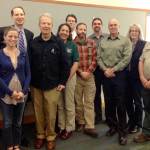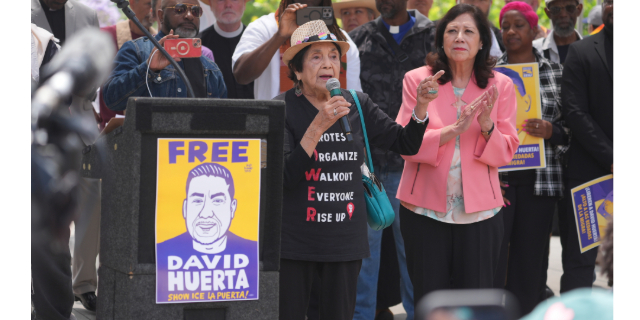Former Ashland Mayor Stromberg remembered by those who worked with him
Published 12:42 pm Monday, June 9, 2025



‘As a policy maker, he talked to everyone. He understood everyone’s point of view’
Ashland Fire & Rescue Wildfire Division Chief Chris Chambers remembered when he first met John Stromberg — as another property owner skeptical that he really had to part with plants on his land for wildfire mitigation.
“I would say initially, he didn’t understand the need to do the work in his front yard. He was like, ‘But these are beautiful plants!’” Chambers remembered.
True to form, Stromberg “worked through it; he was able to step back and see the issue another way,” Chambers said. Then, during his service as mayor from 2008 to 2020, he became a champion of wildfire mitigation with a legacy that retains momentum to this day, Chambers said.
Stromberg died May 23. He was 85.
Dennis Slattery — who served on the Ashland City Council while Stromberg was mayor — remembered his friend’s leadership in all things as collaborative, ingenious and creative. But in wildfire mitigation, his friend showed vision.
“It wasn’t on the map, it wasn’t an easy sell,” Slattery said.
Ashland Forest Resiliency groundwork laid just before Stromberg’s service
Ashland’s watershed has been protected jointly by the U.S. Forest Service and the city of Ashland since the 1890s, Chambers said. A “command and control,” concept of forest management was applied to all public forests by the USFS following a series of massive wildfires in the 1910s, he said.
“They really shaped the public’s consciousness around fire,” he said.
Following World War II, airplanes, equipment and trained men were available for imposing further control of the forests.
At the turn of the last century, examination of modern data compared with historical data showed a dense overgrown forest threatening as-yet-unseen megafires such as the Camp Fire in California. Forest Service staff began coming to city of Ashland staff to share the data, urging action.
“Every fire suppressed would have burned some of the fuels and reduced the density of the forest. … The data showed three times the tree density there should be in some places,” Chambers said.
At the time, the towns and forests of Southern Oregon had just experienced the “timber wars” to protect the territory of species such as spotted owls, he said. Ashland was no longer a logging town. Removing fuels would be expensive in social and financial capital.
The first Community Wildfire Protection Plan was created in 2004 — an endeavor being updated by the city this year — but the city didn’t “start any chainsaws” on the project until 2010, Chambers said. It took time to build the momentum.
Stromberg exercises creative leadership, forward thinking
The public’s initial skepticism on a new forest management policy for a new threat was matched with Stromberg’s enthusiastic dedication to public outreach.
“As a policy maker, he talked to everyone. He understood everyone’s point of view. … Any event you asked him to attend, his answer was always ‘yes,’” Slattery said.
Asked about Stromberg’s organizing a two-hour “deer summit” to approach the problem of aggressive deer in Ashland, Slattery laughed.
“That was his style, that was how he went about things,” he said.
Slattery also remembered his friend passionately supporting arts and culture, maybe as a reflection of his own creative spirit.
Indeed, John and Jane Stromberg’s support of the arts was recognized in Eugene, where they lived for 14 years before moving to Ashland in 2000. John received the Heart of the Arts award for his work creating a public-private partnership to save the city of Eugene’s public art gallery. He also co-chaired the Eugene’s Commission on the Future of the Hult Center for the Performing Arts.
Their devotion to public service continued and grew in Ashland.
Councilor Gina DuQuenne remembered Mayor John Stromberg eagerly accepting her invitation to serve as grand marshal of the city’s first Pride Parade.
State Rep. Pam Marsh, D-Ashland, said Stromberg’s greatest love as mayor was bringing people together, and from that spirit, his biggest accomplishment was in the watershed.
“By far, his biggest accomplishment was coalescing the city, state and federal partners around work in the Ashland watershed. Because of his efforts, Ashland became a national example of smart, collaborative and science-based wildfire risk management,” she said.
“He did that not by directing from afar, but from getting into the work, recruiting partners, listening to experts, and truly understanding and communicating the importance of the work,” she added. “He was such a good man. I will miss him.”
“We have rooms at city hall with lots of plaques, awards and photos — so many of them involve John,” Mayor Tonya Graham said.
The diplomatic but passionate spirit was matched by his intelligence, Chambers said, remembering Stromberg’s doctoral degree in business administration and a career in systems management, including work with the RAND Corporation, the noted think tank. On many trips to Salem, and once to lobby for federal support for the city’s forest management in Washington D.C., Chambers said he appreciated Stromberg’s interesting conversation and quirky sense of humor.
“He called this work our ‘skunk works.’ No idea why,” Chambers said.
Starting work in the watershed
Bringing together partners such as the Lomakatsi Restoration Project and the The Nature Conservancy, along with support from the U.S. Forest Service, Stromberg was able to secure an initial $6 million dollars and enough public support to start wildfire mitigation work in the spring of 2010, Chambers said. Then helicopters began carrying logs out of the watershed, and funds began to draw down accordingly.
“Helicopters are expensive,” Chambers said.
Stromberg came out to tour the watershed and was able to tabulate the work done against the cost and the work visibly left to do as opposed to the funds remaining.
“He looked around and was like, ‘Who’s going to come up with the money for the rest of this project? Oh it’s me,’” Chambers said.
After the lobbying trip to D.C. where Stromberg and his wife, Jane, managed to get a few minutes with then-President Barack Obama and the top brass of the forest service, Stromberg determined the city would need to put “skin in the game,” to get additional support. He convinced the City Council to pass the first fee to fund the Ashland Forest Resiliency project, Chambers said.
Originally called the AFR fee, the recently renamed Wildfire Mitigation fee was raised in April to support expanded wildfire mitigation work. The city also completed additional helicopter logging for forest health last year. Tying the fee to the water meter was intended to create a tax that would be equitable rather than regressive in order to have a stable source of funding to support protection of the city’s watershed.
“That in itself was pretty groundbreaking; not many places in the country or the world have done that,” Chambers said.
To dispose of all the fuels coming out of the dense forests, the city needed to burn materials and the forest couldn’t be so easily divorced from fire. The same ideas that led to fire suppression forestry led to the prohibition of ancient Native practices of managing the forests with controlled fire.
“It was recognizing that we really need to restore fire to the landscape. Fire is an essential process, it shaped these forests, it evolved with species, it evolved with people,” Chambers said.
Oregon’s smoke management policy was and is conservative to protect air quality, he added. It took multiple trips to Salem to bring state policymakers to the understanding Ashland needed to create some additional smoke to prevent more smoke from wildfires.
“He would bring me along to Salem. Sometimes he would get up out of his chair and say, ‘I’m going to let Chris Chambers tell you about this,’” he said.
Once the state redefined allowable “intrusions” in its smoke management policy, Stromberg helped shepherd in a package of land use code changes suggested by a previous fire marshal to ensure new construction, including landscaping in the city of Ashland, would be more fire resistant. Landscape architects and developers were initially skeptical of the need for these changes, Chambers said. Around a year of stakeholder meetings led by the mayor brought the code changes to fruition in 2018.
Slattery said the wildland urban interface area around the city could be named for Stromberg. Through his efforts, Ashland was able to start wildfire mitigation work — with its lengthy bureaucratic and funding hurdles — years ahead of when forest fires began stepping out of forests and making the risk of megafires undeniable.
“He built a really strong legacy of public participation and awareness, it was pivotal with mobilizing funding for wildfire mitigation and to preserve Ashland as a mountain forest community that can thrive,” Chambers said.
Email Ashland.news reporter Morgan Rothborne at morganr@ashland.news. This story first appeared at Ashland.news.









